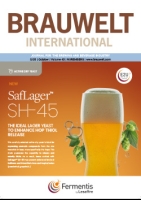Man, you’d think Armageddon is just round the corner, what with all of the tweets, blog posts and articles I’ve seen commenting on a spate of craft beer deals that shook the industry in 2015. While I was waiting in vain for apocalyptically boiling oceans, rains of fire and rivers turned to blood, doomsday preppers wailed and gnashed their teeth because, in contrast to me, they had interpreted the signs as ushering in The End of the World as We Know It.
On November 12th, 2015 the Ludwig Narziß Award for Brewing Science was bestowed at BrauBeviale for the first time. In her opening address, Dr. Lydia Winkelmann, Editor-in-Chief of BRAUWELT International, briefly summarised the background to this award (BRAUWELT International no. 4, 2015, pp. 238-240). She thanked everyone who contributed to initiating the award, e.g. Dr. Jörg Lehmann, Chairman of the Association of Weihenstephan Brewing Studies Alumni, former PhD students of Prof. Dr. Ludwig Narziß, who very decisively gave conceptual and financial support and, ultimately, the eponym. For more than 60 years – the scientific journal BrewingScience, Fachverlag Hans Carl, has facilitated knowledge transfer among researchers and for use in practice for all that time –, he was not just instrumental in shaping science, he also had a formative influence in dissemination of scientific knowledge for everyday application.
After 2001, beers imported from Europe disappeared from specialist bars in Argentina, and many beer-drinkers who had hitherto enjoyed Newcastle, Samuel Smith, Chimay, Fuller, etc., began to wonder how this custom of drinking “different” beers could be maintained in a country with scant brewing history. This marked the beginning of home brewing in Argentina, and the birth of „Dorada Pampeana“. Marcos Ragoni, biochemist, microbiologist and Quality Control Manager at Compañia Cervecera Mataderos SRL, Buenos Aires, describes the development of craft brewing in Argentina and introduces a unique Argentine beer style.
According to the current Barth report for 2014/2015, global beer production dropped by 11.8 million hectoliters (–0.6 %) compared to 2013 (see table 1). This has been influenced by the general state of unrest around the world, the Ebola epidemic and political upheavals. To date, the only years in which world beer production fell were recorded in 1992 (–0.2 %) and 1984 (–0.4 %).
As German brewers prepare to celebrate the 500th anniversary of the Reinheitsgebot this year, taking pride in the fact that for five centuries their beers have only been made with water, barley, hops and yeast, the rest of the beer world will politely acknowledge this achievement and move on. No doubt, the Reinheitsgebot has contributed to brewing culture but times are changing. The old battle cries “German beer versus chemical beers” do not resonate any longer with consumers abroad as the global beer discourse has already shifted to “big brands versus craft”.
Citizens of Switzerland have asserted their desire for more “Swissness” in the past twelve months, particularly in the political arena. As a result of recent political developments in the European financial sector, the effects range from noticeable to severe, depending on the branch of industry or commerce. Although the disadvantages associated with this development will not be far-reaching for consumers over the interim, appreciable effects on wage levels and purchasing power are elements of concern.
Clever AB-InBev. With consumer interest for U.S. craft beers rising in many parts of the world, they did not wait for their competition to fill the shelves, they did it themselves. After launching the Goose Island craft beer brands in The Netherlands and Belgium last year, they are now taking the Hawaiian Kona beer to Australia and Latin America.
Bad timing. Two of the world’s major brewers released their annual results on the same day. And they could not have been more different. While Dutch Heineken benefitted from rising demand for premium beers in Latin America, the Danish brewer Carlsberg continued to suffer from declining demand in Russia.
Should Jim Koch, the founder and public face of Samuel Adams beer ever seek a career change, he should consider becoming a motivational speaker.
The Brewers Association may boast that craft beer exports are growing by double digits, but on close inspection one can see which brands are actually benefitting from foreign markets’ pull: they are AB-InBev’s “crafty brands”. Last year already its Goose Island beers were sitting prominently on Dutch and Belgian supermarket shelves.


